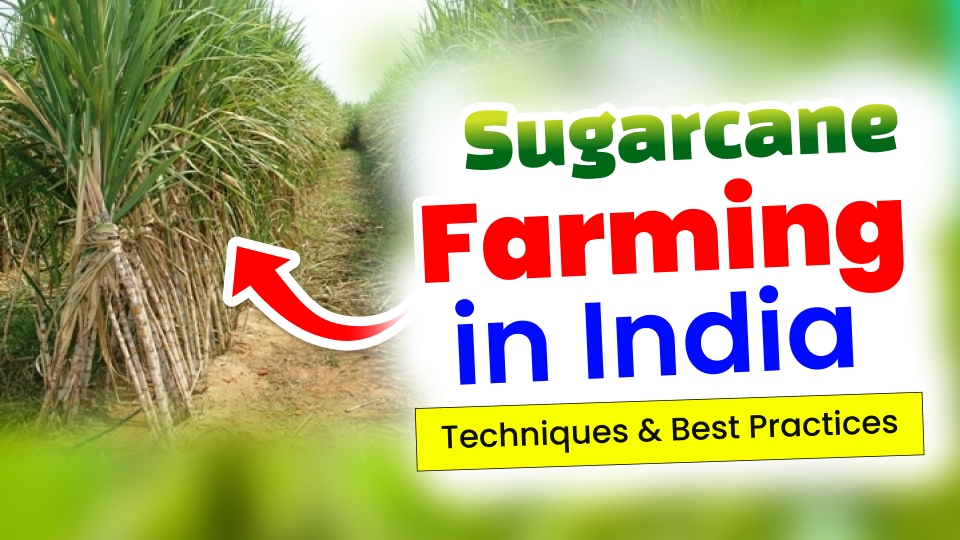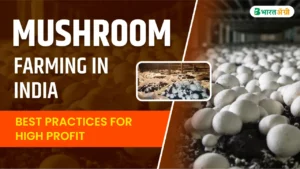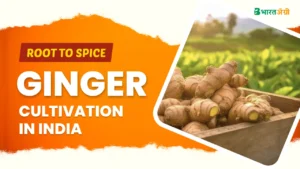
Sugarcane farming in India is significant in the country’s agricultural landscape. As one of the world’s largest sugarcane producers, India contributes substantially to the global sugar industry. Sugarcane, a tropical crop, is not only a source of sugar but also an essential raw material for industries such as ethanol production, paper, and alcohol. This comprehensive guide explores the various aspects of sugarcane farming in India, from the biological characteristics of the crop to modern cultivation practices and pest management strategies.
Sugarcane Crop at a Glance
Sugarcane (biological name: Saccharum officinarum) is a perennial grass crop primarily grown for its high sugar content. The crop thrives in tropical and subtropical regions and is typically harvested in a 10-18 month cycle depending on the variety and climate conditions.
- Cropping Season: Sugarcane cultivation is done in three seasons: pre-seasonal (October 15 – November 30), Adsali (July 15 – August 15), and Suru (December 15 – February 15).
- Crop Type: Perennial grass.
- Production: India is the second-largest producer of sugarcane globally.
- Consumption: Primarily used for sugar production, with by-products used in ethanol, molasses, and bagasse for power generation.
- Export: Significant exporter of sugar and ethanol, contributing to foreign exchange earnings.
Highest Sugarcane producing state in India
Sugarcane is predominantly grown in the following states:
- Uttar Pradesh: Largest producer, contributing to over 40% of the total production.
- Maharashtra: Known for high recovery rates of sugar.
- Karnataka: Significant production, known for sustainable farming practices.
- Tamil Nadu: High yield per hectare, with advanced irrigation techniques.
- Bihar: Emerging as a significant producer with modern farming techniques.
Required Climatic Conditions
Sugarcane requires specific climatic conditions for optimal growth:
- Temperature: Ideal range is 20°C to 35°C.
- Rainfall: Requires 750-1200 mm annually, evenly distributed.
- Sunlight: Needs bright sunshine for photosynthesis and growth.
- Frost: Should be avoided as it can damage the crop.
Soil Requirement
- Type: Loamy soil with good drainage and aeration.
- pH Level: Slightly acidic to neutral (6.5 to 7.5).
- Nutrient Content: Rich in organic matter with adequate levels of nitrogen, phosphorus, and potassium.
Land Preparation
Prepare the land by ploughing once or twice, depending on the soil type. Mix 5 tons of Farm Yard Manure (FYM) and 3 Liter of composting bacteria in the field, allowing it to decompose in open air for 10 days. Spread this mixture evenly over the soil and use a rotavator to achieve a fine tilth throughout the field. Prepare raised beds, 120 cm wide bed preparation, by using a tractor.
Sowing
- Method: Mainly done through sets (cuttings) which are pieces of the cane stalk and transplanting of the sugarcane saplings.
- Timing: Best planted during spring or autumn for optimal growth.
Seed Rate
- Quantity: Approximately 40,000 to 50,000 two-eyed setts per hectare.
- Quality: Use healthy, disease-free setts for planting.
Variety
Choosing the right Sugarcane veriety based on climatic conditions and soil type is crucial for successful cultivation. Popular varieties include:
Here are the top 10 sugarcane varieties and their features:
- Co 0238: Best sown in February-March; known for high yield and excellent sugar recovery.
- Co 86032: Planted in January-February; resistant to red rot and offers high sugar content.
- Co 0118: Sowing in February-March; features high tillering and good ratooning ability.
- Co 0239: Best planted in October-November; early maturing with high sucrose content.
- BO 91: Sown in March-April; resistant to smut and offers high cane yield.
- Co 89003: Planted in February-March; drought-tolerant with good ratoon performance.
- Co 86010: Sowing season is January-February; high yield with resistance to diseases.
- Co 7804: Best planted in October-November; early maturity and excellent ratooning.
- Co 95020: Sown in February-March; known for its high sugar recovery and good yield.
- Co 92005: Planted in October-November; high yield potential and resistant to red rot.
Seed Treatment
Before planting, mix 500 ml of Chlorpyrifos 20% EC, 250 gm of Ridomil Gold, and 1 kg of 13:00:45 in 100 liters of water. Treat for 10 minutes to combat fungal diseases and scaly insects.
Spacing
- Row Spacing: Generally 120 cm to 150 cm between rows.
- Plant Spacing: 30 cm to 45 cm between plants within a row.
Nutrient Management
Here are the three different fertilizer doses recommended for sugarcane based on the sowing month:
- Adsali sowing – 160:68:68 N:P:K kg/Acre:
- At sowing: Urea 35 kg, Single Super Phosphate 212 kg, Muriate of Potash 57 kg
- 42-56 days after sowing: Urea 139 kg
- 84-112 days after sowing: Urea 35 kg
- 130-150 days after sowing: Urea 139 kg, Single Super Phosphate 212 kg, Muriate of Potash 57 kg
- Pre-seasonal sowing – 136:68:68 N:P:K kg/Acre:
- At sowing: Urea 30 kg, Single Super Phosphate 213 kg, Muriate of Potash 57 kg
- 42-56 days after sowing: Urea 118 kg
- 84-112 days after sowing: Urea 30 kg
- 130-150 days after sowing: Urea 118 kg, Single Super Phosphate 213 kg, Muriate of Potash 57 kg
- Suru sowing – 100:46:46 N:P:K kg/Acre:
- At sowing: Urea 22 kg, Single Super Phosphate 150 kg, Muriate of Potash 40 kg
- 42-56 days after sowing: Urea 87 kg
- 84-112 days after sowing: Urea 22 kg
- 130-150 days after sowing: Urea 87 kg, Single Super Phosphate 138 kg, Muriate of Potash 37 kg
These fertilizer schedules ensure optimal nutrient supply at different stages of sugarcane growth, enhancing crop yield and quality.
Irrigation Management
- Frequency: Regular irrigation is crucial, especially during the early stages.
- Methods: Drip irrigation, furrow irrigation, and sprinkler systems are commonly used.
- Water Management: Avoid waterlogging; ensure proper drainage.
Herbicide for Sugarcane
Herbicides used in sugarcane cultivation are crucial for weed control, ensuring optimal growth and yield. They are selected based on their effectiveness against specific weed species while being safe for sugarcane plants.
Spray Metribuzin 70 wp 300 gm + Weedmar Super 24d herbicide 500 ml per acre, 20 days after sowing.
Spray Sempra herbicide 36 gm per acre, if there is nutsedge in maize field.
Intercultural Operations
- Weeding: Regular weeding is essential to prevent competition for nutrients.
- Gap filling: Involves placing sprouted setts into gaps where germination has not occurred, typically done around 30 days after planting.
- Earthing-up is performed in two stages:
- Partial earthing-up occurs at 45 days after planting (DAP), where a small amount of soil is taken from either side of the furrow and placed around the base of the shoots.
- Full earthing-up is done at 120 DAP, where soil from the ridge between the furrows is completely removed and placed near the cane on both sides.
- Wrapping in sugarcane: Involves covering the cane setts with layers of sugarcane leaves or other materials to protect them during transportation or storage, preventing dehydration and damage. This method helps maintain the quality and viability of the cane setts until planting.
Intercropping in Sugarcane
Intercropping in sugarcane varies with the planting season:
- Kharif Planting: Groundnut, soybean, winged bean, and non-creeper vegetables like spinach, coriander, fenugreek, and onion are commonly intercropped.
- Rabi Planting: Intercrops include potato, onion, garlic, green peas, cauliflower, cabbage, and gram.
Intercropping helps optimize land use and diversify crop outputs, enhancing overall farm productivity and sustainability.
Crop Protection
Crop protection includes pest and disease management. Below are the pests and diseases that affect Sugarcane crops.
Pest Management
Early shoot borer
Dead heart shows in 1-3 months old crop, which can be easily pulled out. Caterpillar bores into the central shoot and feeds on the internal tissue cause Dead heart.
Cultural Control: Light earthing up 1 to 1.5 months with immediate irrigation. Early planting during December – January escapes the early shoot borer incidence.
Mechanical Control: Install pheromone traps @ 5 Unit per Acre.
Chemical Control: Drench Super D Insecticide (Chlorpyriphos 50% + Cypermethrin 5% EC) 1 liter OR Chlorantraniliprole 18.5% SC – 150 ml per acre.
Internode Borer and Top Shoot Borer
Internodes constricted and shortened, with a number of boreholes. Top shoot borer Caterpillars are mainly found in the apical portion of canes, boring through the growing point and down the upper joints until it reaches the sappy portion of the stem.
Chemical Control : Apply Regent Ultra 8 kg per acre with fertilizer.
White fly
Leaves begin to yellow and then become pale. They may turn pinkish or purple before gradually drying out. Infested leaves often appear white with black dots.
Organic Control: Spray Neem oil @ 2 ml per lit water
Chemical Control: Spray Acetamiprid 20% SP – 0.5 gm OR Thiamethoxam 25% WG – 0.5 gm OR Ulala Insecticide 0.4 gm OR Imidacloprid 17.8% SL – 0.5 ml per liter
Sugarcane wooly Aphid
Leaves start yellowing and drying from the tips along the edges. They become brittle and eventually dry out completely. Excessive honeydew secretion promotes the growth of sooty mold.
Chemical Control: Spray Super D Insecticide – 2 ml OR Profex Super – 2 ml per liter water.
White Grub
Leaves turn yellow and wilt. The entire crown dries out. Affected canes can be easily pulled out. Extensive damage occurs to roots and the base of the shoot. Affected canes exhibit lodging in the field.
Organic Control : Drench Metarhizium Anisopliae 1 or 2 liter per acre.
Chemical Control: Drench Super D 1 liter OR Police (Fipronil 40 % + Imidacloprid 40% WG) 200 gm per acre.
Termite
Semi-circular feeding marks appear on the edges of the leaves in the standing crop. Germination of setts is poor after planting. The outer leaves turn yellow and dry first, followed by the inner leaves.
Organic Control : Drench Metarhizium Anisopliae 1 or 2 liter per acre.
Chemical Control: Drench Super D 1 liter OR Police (Fipronil 40 % + Imidacloprid 40% WG) 200 gm OR Bifenthrin 10% EC 400 ml per acre.
Disease Management
The following disease are harmful to Sugarcane farming and directly affect the yield of the sugarcane crop.
Red rot
In the early stages, symptoms of the disease may be hard to detect in the field. As the disease progresses, red rot can cause the cane to collapse or “break down.”
Chemical Control: Drench Amistar Top OR FMC Azaka Duo 200 ml per acre, 25 days after planting.
Smut
A distinctive symptom of the disease is the emergence of a black, whip-like structure from the central core of the meristematic tissue. This flagelliform appendage, often referred to as the whip, starts off straight when young but becomes irregularly curved as it matures.
Preventive Measure: Set treatment of Ridomil Gold 250 gm in 100 liters of water.
Grassy Shoot
This disease leads to the growth of numerous small and thin tillers with narrow leaves. Infected plants show varying degrees of chlorophyll loss, ranging from fully green to white. The premature and excessive tillering results in a crowded, grass-like appearance.
Organic Control: Spray Verticillium Lecanii 5 ml per liter water.
Chemical Control: Spray FMC Rogor (Dimethoate 30% EC) 1 ml per liter water.
Rust
The initial signs of common rust on leaves are small, elongated yellowish spots that appear on both surfaces. These spots gradually enlarge, primarily in length, and change to a red-brown to brown color.
Organic Control: Spray Tricoderma Viridi 1 gm per liter water.
Chemical Control: Spray Hexaconazole 5% SC 1 ml OR Indofil Avtar 2 gm per liter water.
Harvesting
Harvesting of sugarcane is done when the cane reaches peak maturity for maximum sugar content.
Yield
- Average Yield: 50 tonnes per acre, Sugarcane production depending on variety and management practices.
- High Yield: With advanced techniques and proper management, Sugarcane yield per acre can exceed 100 tonnes.
Conclusion
In summary, sugarcane farming in India is a dynamic and essential part of the agricultural sector. With the right knowledge of climatic requirements, soil management, pest control, and harvesting techniques, farmers can achieve high yields and contribute significantly to the sugar industry. Understanding and implementing these practices ensures the sustainability and profitability of sugarcane farming in the country.
FAQs
The best Sugarcane seasons are spring (February-March) and autumn (September-October)
Loamy soil with good drainage and a pH level of 6.5 to 7.5 is ideal.
Sugarcane requires 750-1200 mm of rainfall annually, with irrigation during dry periods.
Common pests include shoot borer, top borer, and white grubs.
Sugarcane is harvested manually or mechanically when it reaches peak maturity, with leaves and tops removed before transportation to mills.



